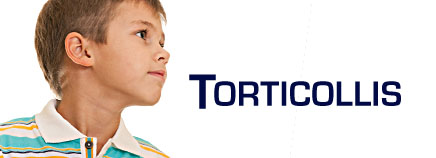Torticollis is a common condition among infants characterized by an asymmetrical positioning of the head and neck. Typically with torticollis, an infant will present with a preference for tilting the head in one direction while turning it to the opposite side. Neck tightness, muscle weakness, and abnormal balance reactions are often observed with this diagnosis. It is also possible for the shoulder and trunk muscles to become tight and asymmetrical. Similarly, facial and skull asymmetry (plagiocephaly or brachycephaly) can occur with torticollis as can gross motor delay, postural asymmetry, balance dysfunction, visual disturbance, and abnormal patterns of movement.
What Causes Torticollis?
Intrauterine malposition is a common cause of congenital muscular torticollis. Babies born in the breech position and multiples are at increased risk for developing torticollis as these are situations in which in-utero positioning is altered and the ability for the developing baby to move is compromised. Positioning after birth can also contribute to torticollis. If the infant is always faced in the same direction or positioned in the same way, they may develop a preference for turning their head to one side. Additionally, a head preference can quickly become reinforced by the development of a flattened area on the skull (plagiocephaly or brachycephaly).
What Can be Done?
Early Intervention is critical to the success of treatment. Therapy can begin as soon as an infant presents with a head preference and can assist in the prevention of many of the secondary complications associated with this diagnosis. Physical therapy may include gentle stretching, positioning, gross motor developmental activities, strengthening, and education to families in home exercise. Should skull asymmetry be a factor and not respond to therapy, your therapist can assist you in finding a resource to address this concern.
Our Approach
Pediatric therapists at Fox Valley Physical Therapy and Wellness have completed special training in the evaluation and treatment of torticollis. Evaluation will include assessment of the child’s ability to move the neck, arms, and legs; postural control; balance reactions; skull/facial asymmetry; and gross motor ability. A treatment plan based on the child’s specific needs will be developed. Outpatient services will be recommended if necessary and an appropriate treatment frequency will be initiated. A focus of our treatment approach is the facilitation of active movement by the child that will serve to elongate tight muscle groups as well as strengthen weakened areas thereby facilitating symmetrical movement of the head and neck. Gentle elongation of the involved muscles can also be achieved through positioning and proper carrying techniques as well as through the use of soft tissue massage. Traditional stretching exercises can often result in increased tension rather than the desired response; therefore our treatment of these clients utilizes a more active approach. Age-appropriate developmental activities can encourage typical movement patterns and will enable the child to keep pace with their expected skill level.
Our Results
Expected outcomes with early intervention include: full neck range of motion; good strength for the neck, shoulders, and trunk; symmetrical posture for the head, neck, and trunk; typical movement patterns; and age-appropriate gross motor skills.
Questions?
If you have questions about whether or not your child has torticollis or how you can get started with physical therapy, please contact our pediatric experts at 630-549-0511.
Posted on: September 21, 2012 | FVPT In The News



